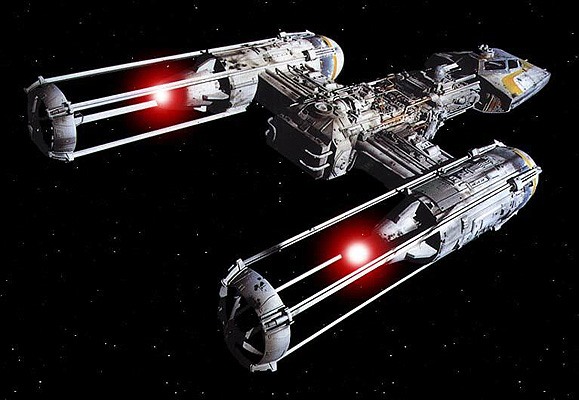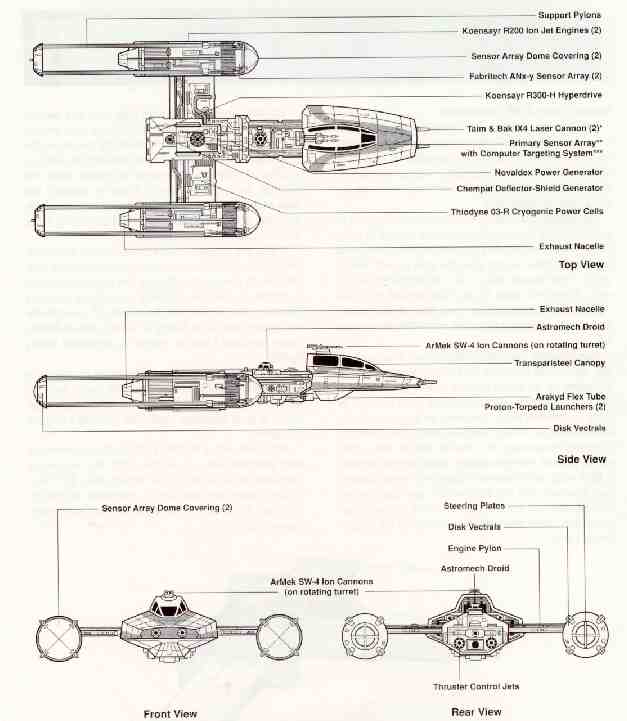
MEMBER ACCOUNT
EMPEROR'S HAMMER
TIE CORPS
OPERATIONS
- Battle Center
- Patch Archive
- Competition Center
- Combat Center
- Imperial University
- Mission Creation Center
- Fiction Center
DATA CENTER
- Killboards
- Squadron Battleboards
- Pilot Statistics and Ranks
- Medal Board
- Uniforms
- Roster Tools
- Complete Craft List
- Multiplayer Game Points
COMMUNICATIONS
EH SUBGROUPS
REFERENCE & MANUALS
- Encyclopaedia Imperia Wiki
- TIE Corps Pilot Manual
- SO Dark Side Compendium
- COO Manual
- Tactical Manual
- Fleet Manual
- Training Manual
- System Manual
- Fleet Order of Battle
EH POLICIES & INFO
UTC
Y-Wing Advanced Knowledge Notes

History
Koensayr Manufacturing builds a wide range of starships and starship components; they can boast having components in nearly a fifth of all starships in production. Parts alone account for 72% of their profits. But, by far, their most famous product is the BTL fighter, also known as the Y-Wing. Known as a "wishbone" to Rebel Alliance and New Republic pilots, the Y-wing starfighter was deployed as a fighter-bomber, designed to fight its way to its objective, deliver its payload of high explosives, and fight its way out again. Y-Wing starfighters hold the dubious record of being the most-destroyed military vessel in the Alliance arsenal. This is not due to any design flaw in the Koensayr starfighter. Rather, it is the result of it being the most common starfighter the Alliance had at its disposal during the Galactic Civil War. Predating the Incom X-Wing, the Koensayr Y-Wing figured prominently in the Rebellion's early skirmishes. They proved their value in the Battle of Vnas at Duro, and the Battle of Ord Biniir. During the Siege of Ank Ki'Shor, Y-Wing fighters saved thousands of lives by holding off attacking TIE bombers. The Y-Wing was still considered a top of the line fighter as recently as the Battle of Nar Shadda (5 years before the battle of Yavin) but today it is considered a second rate craft. No longer as fast, maneuverable, or heavily armed as other starfighters, the Y-Wing remains a potent craft able to endure and deliver tremendous punishment. In the later years of the Galactic Civil War, Y-Wings were relocated from front-line combat service to base protection and on raids on outlying Imperial convoys. Many Y-Wings have been pushed into courier duty for Intelligence services. This is where the most interesting Y-Wing variants can be found. Some courier Y-Wings have done away with the ion weapons, replacing the cannon power systems with luggage space. These fighters feature special split canopies for faster ingress or egress when landed (or even, as reported by some, high-altitude exits). Some modified Y-Wing fighters have detachable cockpits that served as repulsor-powered escape vehicles.
Design
The Y-Wing is designated an attack fighter, giving it a wide range of combat applications. Capable of respectable performance in one-on-one fighter engagements, its durable spaceframe is also well suited to carry heavy-armaments. With little or no modifications, many Alliance units use Y-Wing fighters for bombing craft. The Alliance maintains two basic types of Y-Wings, the single-seater BTL-A4 and the double-seater BTL-S3. There is also an A4 sub-variant called the Longprobe, used for reconnaissance missions. The Y-Wing gets its name from the shape of the craft, which resembles the letter "Y". Also, this led the craft to be dubbed the "wishbone" in pilot jargon. Perhaps the one thing fighter jockeys on both sides of the war will agree on is that the Y-Wing can take a beating. Its durable titanium reinforced Alusteel alloy hull proved a surprise to early enemy pilots who, confident that they had lined up the Y-Wing in their targeting crosshairs, failed to destroy it with a snap-shot. Only by repeatedly dogging the Y-Wing will a pilot's lasers cut through its hull. The cockpit module is protected by sturdy armor plating. This hull plating originally covered the entire Y-Wing body, but since the ship requires maintenance after virtually every flight, the mechanics grew weary of constantly removing and replacing panels so they have finally left the body plating off entirely. This lowers the Y-Wing’s hull rating substantially and leaves vital components exposed to enemy attack, however it still remains quite durable. Koensayr equipped all Y-Wings with an astromech droid socket about a third of the way back along the central spar. When in place, the droid, usually an R2 or R5 unit, connects directly to the fighter’s central circuit matrix and monitors all flight, engine, and power systems. By regulating fluctuations and surges and adjusting trim controls, the droid provides a smoother flight and frees the pilot to concentrate on other, less mundane tasks. Like most rebel fighters, the Y-Wing can make hyperspace jumps, but doesn’t carry a powerful enough navigation computer to fully calculate the necessary course vectors and power settings. An R2 unit, however, can store the necessary data and make final adjustments for 10 jumps. The simpler R5 droids can handle only a single jump safely, so they are seldom used for hyperspace travel. A single canopy encloses the cockpit. Large flat armored transparisteel plates give the crew all-around visibility, but greatly restrict vision above and below the fighter. Many crews install camera’s to cover those areas.
Weapons
The Y-Wing is armed with, 2 Taim and Bak KX5 Laser Cannons mounted on the nose (early versions and many BTL-S3's used IX4 cannons). These cannons are bore-sighted to the craft’s flight path. These short-barrelled lasers draw power from a single Nocaldex generator at the rear of the central spar. Shielded power lines run along the outside of the spar forward to the cockpit module. A pivot mount at the back of the cockpit holds 2 ArMek SW4 Laser Cannons. In the BTL-A4, a single seat Y-Wing, a targeting computer was supposed to aim and fire the ion cannon. However, the computer’s performance was so poor during the production testing that it was removed. Now, single seat Y-Wings fire their ion cannons from a fixed position only. However, pilots set the firing position before each flight. Most pilots aim the cannons straight ahead for simplicity, but some chose to aim them straight back. In the two seat S3 variant, the weapons officer, who sits facing aft, operates the ion cannons mounted above him. The ion cannons can pivot 360 degrees and elevate up to 60 degrees. By rolling the ship, the pilot can bring the guns to bear on any target around the ship For attacking heavily armed targets, Y-Wings carry 2 Arakyd Flex Tube Proton Torpedo Launchers, mounted on the underside of the cockpit module. Each launcher is fed from a central magazine, so either can fire the full load of 8 torpedoes. Ground crews can swiftly and easily reload torpedoes by replacing the entire magazine, which form-locks into the bottom of the hull.
Engines and Systems
The twin massive Koensayr R200 Ion Jet engines (rated at 250 KTU) propel the starfighter in realspace, and each engine nacelle is topped with sophisticated sensor arrays. In an atmosphere, these ion fission engines work in conjunction with recessed repulsorlift generators to attain speeds of 1,000 kilometers per hour. The Y-Wing's maneuverability comes from a pair of thruster control jets in the aft-face of the central spar. Additional agility is afforded by disk-vectrals set in the end of the engine nacelles to redirect thrust. The Y-Wing's R300-H hyperdrive motivator yields a Class One performance on standard astrogation routes. The S3 model does not have a hyperdrive backup. In the BTL-A4 Longprobe variant, the gunner's station is replaced with a nav computer and backup systems. The slower backup is equivalent to a Class Six hyperdrive. Three repulsorlift thrusters float the fighter off its landing gear for movement in the tight confines of hangars and bases. These repulsors operate only when the landing gear are down. On the ground pilots control the repulsors with a tiny joystick underneath the left canopy edge. A duplicate controller under the nose lets ground crewmen direct the fighter while walking alongside it.
Shadow Y-Wing (SY-W)
The SY-W is the IW's premier heavy support/heavy strike fighter. While being sniffed at for being a Y-Wing- and all the negative things that suggests- the SY-W is actually a more capable craft than the B-Wing, and certainly more useful than it's true-Imperial counterpart, Cygnus' Assault Gunboat. The SY-W is equipped with the standard Y-Wing compliment of twin Ion Cannons and twin Laser Cannons, and a warhead load of either fourteen proton torpedoes/advanced capability torpedoes, ten heavy rockets, or eight heavy space bombs. A standard combat load is for 14 advanced torpedoes. The craft's shielding and maneuverability have both been improved, as has the fighter's armor plating. While the fighter's speed has also been increased- mainly by tweaking the engines supplied with the fighter- the craft still has a top speed under that of most second-generation starfighters.
Weakness
The major weaknesses of the Y-Wing are multiple. The first of which is its slow speed and sluggish handling. While it does make up for this somewhat with its durability, the Y-Wing is still vulnerable. The second major problem is that of its armor. While it’s shields and base hull are strong, once the shields fail the exposed equipment on the wings and central spar is easily cut to pieces, greatly reducing the craft’s combat abilities. In order to be an effective assault craft, the Y-Wing requires escort when facing enemy fighter craft. The best way to exploit this disadvantage is to operate one group of fighters to draw off the Y-Wing’s escorts, and then use another group to pounce on the under defended craft. Another weakness is that of visibility. The lack of visibility to the top and bottom can inconvenience a Y-Wing in a rolling dogfight or anywhere else sensor accuracy is compromised. The placement of the sensor arrays of the Y-Wing in domes on the front of the engine nacelles can also cause problems. Engine vibrations often throw the antennas out of alignment so the sensors seldom work at full potential. Engine vibrations particularly affect the passive sensors. Skilled weapons officers can adjust sensors in flight, but pilots in single seat Y-Wings must do with reduced information. Sensor misalignment is mostly problematic when detecting targets at long range; within weapons normal weapons range the active targeting sensors are seldom affected.
Starfighter Specifications
 Overview
Overview
Name: Y-Wing
Model: Koensayr BTL-A4/BTL-S3
Designer: Koensayr Design Bureau
Manufacturer: Koensayr Industries
Combat Designation: Attack Fighter
Crew: 1 pilot/1 pilot, 1 gunner
Length: 16 m
Cargo Capacity: 110 kg
Power System: Novaldex power generator
Thiodyne O-3R Power Cells and Ionization Reactor
Propulsion System: 2 Koensayr R200 Ion Fission Engines (250 KTU)
Speed Rating: 70 MGLT/1000 km/h atmospheric
Flight Control System: Subpro NH-7 Avionics Control Package
Navigation: Astromech
Maneuverability Rating: 60 DPF
Hyperdrive: Koensayr R300-H Hyperdrive Motivation Unit (class 1)
Sensor Systems: Fabritech ANs-5d full-spectrum transceiver
Long Range Phased Tachyon Detection Array Model Number PA-9r
Short Range Primary Threat Analysis Grid Number PG-7u
Targeting Computer: Fabritech ANc-2.7 Tracking Computer
SI 5g7 "Quickscan" Vector imaging system
Weapons::
2 Taim and Bak IX4 or KX5 Laser Cannons
2 ArMek SW4 Ion Cannons
2 Arakyd Flex Tube Proton Torpedo Launchers (8 torpedo central magazine)
Shields/Armor:
Chempat Shield Projector (rated at 75 SBD)
Titanium Reinforced Alusteel Alloy Hull (rated at 40 RU)
Special Design Feature:
Turreted Ion Cannon
Koensayr ballistic ejection seat
Detachable cockpit
Variants:
* BTL-B - 23.4m long, 360 degree bubble turret
* BTL-S3 - 16m long, double-seater
* BTL-A4 - locked ion turret
* BTL-A4 LP "Longprobe" - long range recon/220 kg cargo
* SY-W

Credits
Created by written by ?Edits by:
Kreeayt Havok 2011
